Book contents
- Open versus Closed
- Open versus Closed
- Copyright page
- Dedication
- Contents
- Figures
- Tables
- Acknowledgments
- 1 Personality and the Foundations of Economic Preferences
- 2 The Psychology of Ideology
- 3 A Dual-Pathway Model of Openness and Economic Preferences
- 4 Testing the Reversal Hypothesis
- 5 Openness and Partisan-Ideological Sorting
- 6 Openness and Elite Influence
- 7 Political Engagement and Self-Interest
- 8 Personality and American Democracy
- References
- Index
- References
References
Published online by Cambridge University Press: 16 March 2017
- Open versus Closed
- Open versus Closed
- Copyright page
- Dedication
- Contents
- Figures
- Tables
- Acknowledgments
- 1 Personality and the Foundations of Economic Preferences
- 2 The Psychology of Ideology
- 3 A Dual-Pathway Model of Openness and Economic Preferences
- 4 Testing the Reversal Hypothesis
- 5 Openness and Partisan-Ideological Sorting
- 6 Openness and Elite Influence
- 7 Political Engagement and Self-Interest
- 8 Personality and American Democracy
- References
- Index
- References
Summary

- Type
- Chapter
- Information
- Open versus ClosedPersonality, Identity, and the Politics of Redistribution, pp. 247 - 268Publisher: Cambridge University PressPrint publication year: 2017

